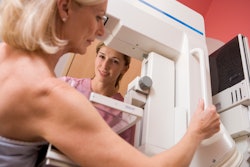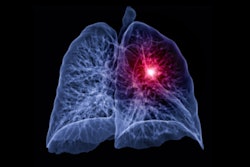Coordinating lung cancer and mammography screening boosts uptake of the former, according to study results delivered November 26 at the RSNA meeting.
"We really have an opportunity with women in particular at the time of mammography," said presenter Kim Sandler, MD, of Vanderbilt University Medical Center in Nashville, TN. "Lung cancer kills more women than breast and ovarian cancers combined, but only 8% of adults recognize lung cancer as the leading cause of cancer-related mortality."
Breast cancer screening with mammography is well used, with 70% of eligible women reporting having undergone a mammogram within the past two years, Sandler noted. But even though the pool of patients eligible for lung cancer screening was expanded in 2021, uptake remains low.
Sandler and colleagues started a patient outreach campaign titled "Mammography saves lives, [and] so does lung screening," an initiative the National Lung Cancer Roundtable picked up under the auspices of its Coordinate A Lung screening with Mammography (CALM) project. As part of the CALM study, Sandler's team identified women eligible for both breast cancer screening with mammography and lung cancer screening (LCS) with low-dose CT (LDCT). It also measured the efficacy of simultaneous interventions to improve enrollment rates of women eligible for LCS among those presenting for mammography screening.
The study included 32,165 women who underwent screening mammography between November 2019 and December 2022 at two academic hospitals. Of the total number of study participants, 1,568 were eligible for LCS; of these, 480 (31%) did undergo LCS and 1,089 (69%) did not.
In an effort to boost LCS uptake, the group used performed the following tasks:
- Querying electronic health records for lung cancer screening eligibility.
- Surveying women at time of mammography to establish lung cancer screening eligibility.
- Distributing patient-oriented materials regarding lung cancer screening.
- Educating primary care providers about lung cancer screening and informing them of eligible patients.
- Enrolling women for lung cancer screening at time of mammography.
The researchers found that the intervention proved successful, with the total number of screenings at Site A (a centralized lung screening program in the Southeast) significantly increasing at 12 months with CALM study interventions compared with the number predicted from preintervention data (p = 0.011). CALM interventions also increased screenings at Site B, a hybrid lung cancer screening center, but this boost was not statistically significant, which Sandler and colleagues hypothesized may have been due to operational effects of the COVID-19 pandemic.
There's much more to be done to encourage women to get LCS, Sandler said. She outlined results from a 2021 study she conducted that included 251 women who all underwent mammography screening and were offered LCS. These women were followed for three years. Out of this cohort, 16 cancers were diagnosed, with four being breast cancer and 10 being lung cancer. There were no deaths in the breast cancer group, but out of the lung cancer group, five women died of the disease.
"Of those 10 women, five lost their lives to lung cancer within three years," Sandler said. "These women were never screened but they all underwent mammography at facilities that also offered LCS. They could have been screened for lung cancer on the same day in the same office."
Radiologists are uniquely positioned to improve LCS uptake, according to Sandler.
"Our outreach efforts are successful," she said. "It's not enough to talk about the low numbers of screening rates -- we as radiologists have an opportunity to change that by combining lung screening efforts with mammography and other cancer screening efforts."




















